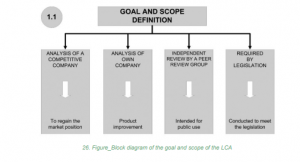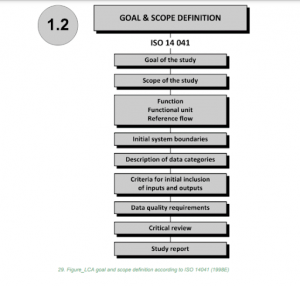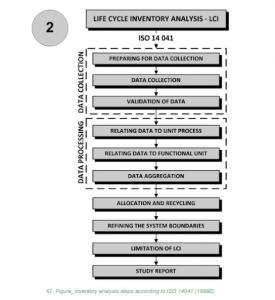Lesson 4: Goal and Scope Definition, and Life Cycle Inventory Analysis
In this introductory lesson on Life Cycle Assessment (LCA), we’ll explore the core concepts and initial phases of LCA, which are fundamental for eco-product design and environmental analysis.
- LIFE CYCLE ASSESSMENT – CORE OF ECODESIGN
To successfully implement ECODESIGN in product development, a foundational understanding of Life Cycle Assessment (LCA) is crucial. LCA provides insights into how products impact the environment, how these impacts are quantified, presented, and ultimately reduced.
- BASICS OF LIFECYCLE ASSESSMENT (LCA)
LCA is an internationally standardized methodology found in the ISO 14040 series. It assesses the environmental impacts associated with all stages of a product’s life cycle, including production, use, and disposal. Environmental impacts result from resource consumption and pollutant emissions.
Phases of LCA:
- Goal & Scope Definition
- Life Cycle Inventory (LCI) Analysis
- Life Cycle Impact Assessment (LCIA)
- Life Cycle Interpretation
A / LIFE CYCLE: A product’s successive stages from raw material acquisition to final disposal.
B / LIFE CYCLE ASSESSMENT (LCA): Collection and assessment of inputs and environmental impacts throughout a product’s life cycle. LCA is an iterative process, balancing complexity and practicality.
- GOAL AND SCOPE DEFINITION

At this very first stage of the LCA process, a work plan is developed for the entire LCA study, guided by ISO 14041. It involves defining:
- Goal of the study
- Scope of the study
- Function, functional unit, and reference flow
- Initial system boundaries
- Data categories description
- Criteria for initial inclusion of inputs and outputs
- Data quality requirements
- Critical review
- Study report
TARGET AUDIENCE: Define the audience and purpose of the LCA study, which could be customers, stakeholders, or internal company use.
SCOPE DEFINITION: Define the product’s function, parts, functional unit, reference flow, system boundaries, and data quality requirements.

- LIFE CYCLE INVENTORY ANALYSIS – LCI
Talking about LCI, which is the second step in the LCA process, Inventory analysis defines the product system, establishes system boundaries, creates flow diagrams, collects data for each process, and performs calculations. Key steps include:
- Preparation for data collection
- Data collection
- Validation of data
- Relating data to unit processes
- Relating data to functional units
- Data aggregation
- Allocation and recycling
- Refining the system boundaries
4.1 PREPARATION FOR DATA COLLECTION: Collect input and output data for unit processes and activities.
4.2 DATA COLLECTION: Quantify inputs and outputs of each unit process; a time-consuming phase that typically spans at least a year.
4.3 VALIDATION OF DATA: Validate collected data for quality by balancing mass and energy or comparing with emission factors.
4.4 RELATING DATA TO UNIT PROCESSES: Define reference flows and calculate environmental loads by unit process.
4.5 RELATING DATA TO FUNCTIONAL UNITS: Relate inputs and outputs of unit processes to the product system’s main output, calculating the environmental load from the product system.
4.6 DATA AGGREGATION: Aggregate input and output data for simplification, either by combining similar processes or environmental impact categories.
4.7 ALLOCATION AND RECYCLING: Handle data for unit processes with multiple inputs or outputs, using allocation and recycling methods.
4.8 REFINING THE SYSTEM BOUNDARIES: Refine boundaries between the product system and the environment, between significant and irrelevant processes, and with other product systems.

Conclusion:
- LCA is a vital tool for assessing environmental impacts throughout a product’s life cycle.
- Goal and scope definition and LCI are crucial phases in the LCA process.
- Transparent data collection and thorough validation are essential for credible LCA results.
- Understanding system boundaries is key to a successful LCA study.